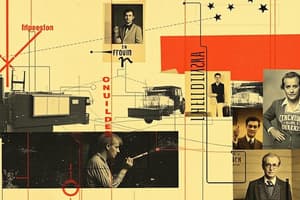Podcast
Questions and Answers
What is the primary purpose of a source in communication?
What is the primary purpose of a source in communication?
- To interpret the receiver's responses
- To send a coded message (correct)
- To receive feedback from the receiver
- To decode the message for the receiver
Which of the following best describes 'message content'?
Which of the following best describes 'message content'?
- The symbols used to convey the message
- The material selected by the source to express their purpose (correct)
- The emotional tone of the message
- The arrangement of information in the message
What are the factors that determine the choice of communication channels?
What are the factors that determine the choice of communication channels?
- Cost and impact of the channels along with source preferences (correct)
- The type of message being transmitted only
- Only the preferences of the source
- Availability of the channels and the weather conditions
What type of effect is characterized as observable and includes non-verbal cues?
What type of effect is characterized as observable and includes non-verbal cues?
Which of these options defines 'feedback' in the communication process?
Which of these options defines 'feedback' in the communication process?
What does the term 'message code' refer to?
What does the term 'message code' refer to?
What kind of communication occurs when an individual communicates with himself?
What kind of communication occurs when an individual communicates with himself?
What does Dance's Helical Model illustrate about the communication process?
What does Dance's Helical Model illustrate about the communication process?
What is a crucial aspect of 'message treatment' in communication?
What is a crucial aspect of 'message treatment' in communication?
Which model illustrates the concept of convergence in communication?
Which model illustrates the concept of convergence in communication?
What does the formula E = Sc + Mc + Cc + Rc + Re represent in communication?
What does the formula E = Sc + Mc + Cc + Rc + Re represent in communication?
Which of the following is NOT classified as a communication barrier?
Which of the following is NOT classified as a communication barrier?
How is 'effect' defined in the context of communication?
How is 'effect' defined in the context of communication?
What type of problems does noise in communication primarily relate to?
What type of problems does noise in communication primarily relate to?
What is a characteristic of the receiver in the communication formula?
What is a characteristic of the receiver in the communication formula?
Which of the following is an example of a semantic problem in communication?
Which of the following is an example of a semantic problem in communication?
What is the primary purpose of an editor making comments on a piece of writing?
What is the primary purpose of an editor making comments on a piece of writing?
Which type of barriers includes factors such as uncomfortable seating and room temperature?
Which type of barriers includes factors such as uncomfortable seating and room temperature?
What does semantic noise refer to in communication?
What does semantic noise refer to in communication?
Which of the following is an example of socio-psychological barriers?
Which of the following is an example of socio-psychological barriers?
What does it mean to have a We-not-Me orientation in communication?
What does it mean to have a We-not-Me orientation in communication?
Which barrier involves the belief that one's own culture is superior to others?
Which barrier involves the belief that one's own culture is superior to others?
What is meant by fidelity in the context of communication?
What is meant by fidelity in the context of communication?
What does a competent communicator need to understand beyond knowing what communication is?
What does a competent communicator need to understand beyond knowing what communication is?
What is a key limitation of Laswell's Model of communication?
What is a key limitation of Laswell's Model of communication?
In Shannon and Weaver's model, what is considered as 'noise'?
In Shannon and Weaver's model, what is considered as 'noise'?
Which model introduces the concept of equilibrium in communication within social relationships?
Which model introduces the concept of equilibrium in communication within social relationships?
What aspect does Osgood and Schramm's Model emphasize in communication?
What aspect does Osgood and Schramm's Model emphasize in communication?
Which of the following best describes Westley and MacLean's Model?
Which of the following best describes Westley and MacLean's Model?
According to Berlo's Model, which of the following elements is crucial for effective communication?
According to Berlo's Model, which of the following elements is crucial for effective communication?
What type of communication is characterized by the use of technological devices to reach large audiences?
What type of communication is characterized by the use of technological devices to reach large audiences?
Which aspect is NOT included in the cyclical representation of Osgood and Schramm's Model?
Which aspect is NOT included in the cyclical representation of Osgood and Schramm's Model?
What is one characteristic of a competent communicator?
What is one characteristic of a competent communicator?
Which of the following is NOT one of the four modified elements of communication competence according to Shockley-Zalabak?
Which of the following is NOT one of the four modified elements of communication competence according to Shockley-Zalabak?
Which component of communication competence refers to understanding the effects of communication choices?
Which component of communication competence refers to understanding the effects of communication choices?
What assumption often leads to ineffective listening?
What assumption often leads to ineffective listening?
Which of the following behaviors demonstrates poor listening during a speech?
Which of the following behaviors demonstrates poor listening during a speech?
The ability to actually demonstrate communication knowledge in various situations is referred to as what?
The ability to actually demonstrate communication knowledge in various situations is referred to as what?
What is essential for maintaining effective communication in a group setting?
What is essential for maintaining effective communication in a group setting?
Which factor is NOT mentioned as a reason people fail to listen effectively?
Which factor is NOT mentioned as a reason people fail to listen effectively?
Flashcards are hidden until you start studying
Study Notes
Communication Process
- A source must transmit a message, which can be an idea, purpose, or intention represented through a code or symbol system.
- The message consists of three factors:
- Message code: Group of symbols structured meaningfully (e.g., language).
- Message content: Material selected by the source to express purpose (e.g., research report).
- Message treatment: Decisions made by the source regarding the selection and arrangement of code and content (e.g., journalist's article angle and word choice).
Channels of Communication
- Channels refer to modes of encoding and decoding messages, including various message vehicles (e.g., sound waves) and carriers (e.g., air).
- Factors determining channel choice: availability, cost, source preferences, impact potential, adaptability to purpose and content.
Effects of Communication
- The outcome or response to a source's message varies, possibly aligning or diverging from the source's objectives.
- Two types of effects:
- Overt Effect: Observable responses like non-verbal cues or signed contracts.
- Covert Effect: Non-observable but impactful, potentially leading to motivation or behavioral changes.
Feedback Mechanism
- Feedback loops occur when individuals communicate internally, affecting both source and receiver.
- Feedback can manifest through verbal or non-verbal cues.
Levels of Communication
- Intrapersonal Communication: Communication with oneself.
- Interpersonal Communication: Face-to-face communication involving one-on-one or small group interaction.
- Mass Communication: Use of technology (e.g., radio, television) to disseminate messages to large audiences.
Communication Models
- Laswell's Model: Focuses on the elements of communication - Source, Message, Channel, Receiver, Effect.
- Shannon and Weaver's Model: Introduces a linear process with noise, highlighting disruptions in message transmission.
- Newcomb's Model: Represents communication relationships maintaining social equilibrium through shared attitudes.
- Osgood and Schramm's Model: Emphasizes mutual roles in encoding, interpreting, and decoding messages, suggesting an endless communication cycle.
- Westley and MacLean's & Berlo's Models: Introduce comprehensive aspects of communication including feedback.
- Dance's Helical Model: Illustrates communication's dynamic nature and cumulative knowledge building.
- Kincaid's Convergence Model: Highlights mutual understanding and agreement among participants.
Barriers to Communication
- Distortions in messages can arise from misinformation or lack of information.
- Noise disrupts clear communication, including technical (e.g., static), semantic (e.g., double meanings), and environmental factors (e.g., distracting settings).
Classifying Communication Barriers
- Technical Problems: Affect transmission accuracy (e.g., poor signal).
- Semantic Problems: Relate to precise meaning conveyance (e.g., mistranslation).
- Effectiveness Problems: Impact how effectively a message influences behavior.
- Common barriers include channel noise, environmental factors, semantic noise, and socio-psychological blocks like stereotyping.
Effective Communication
- Competent communicators possess knowledge, skills, sensitivity, and values that enhance interaction quality.
- Characteristics of competent communicators include a collaboration orientation, understanding of communication effectiveness, and context awareness.
Listening Challenges
- Common failures in listening:
- Prejudging the importance of messages before they are communicated.
- Focusing on the speaker's delivery flaws rather than content.
- Formulating rebuttals instead of listening.
- Overemphasizing factual data at the expense of context.
- Outlining everything heard, leading to missed information.
- Pretending to listen while disengaging from the message.
- Allowing for unclear or incomplete communication without seeking clarification.
Studying That Suits You
Use AI to generate personalized quizzes and flashcards to suit your learning preferences.




